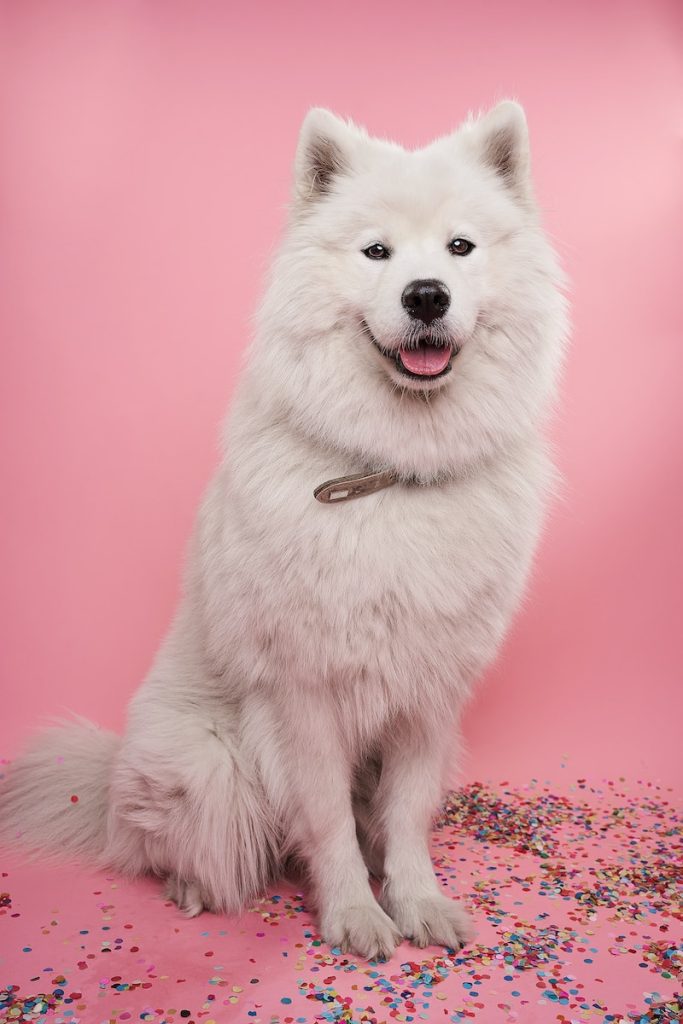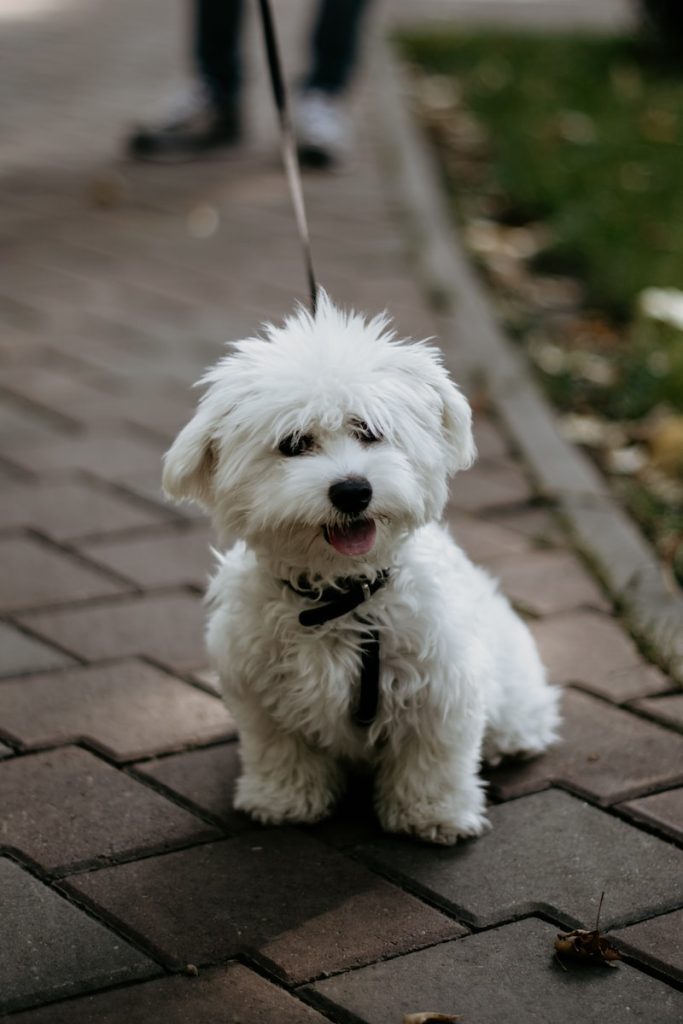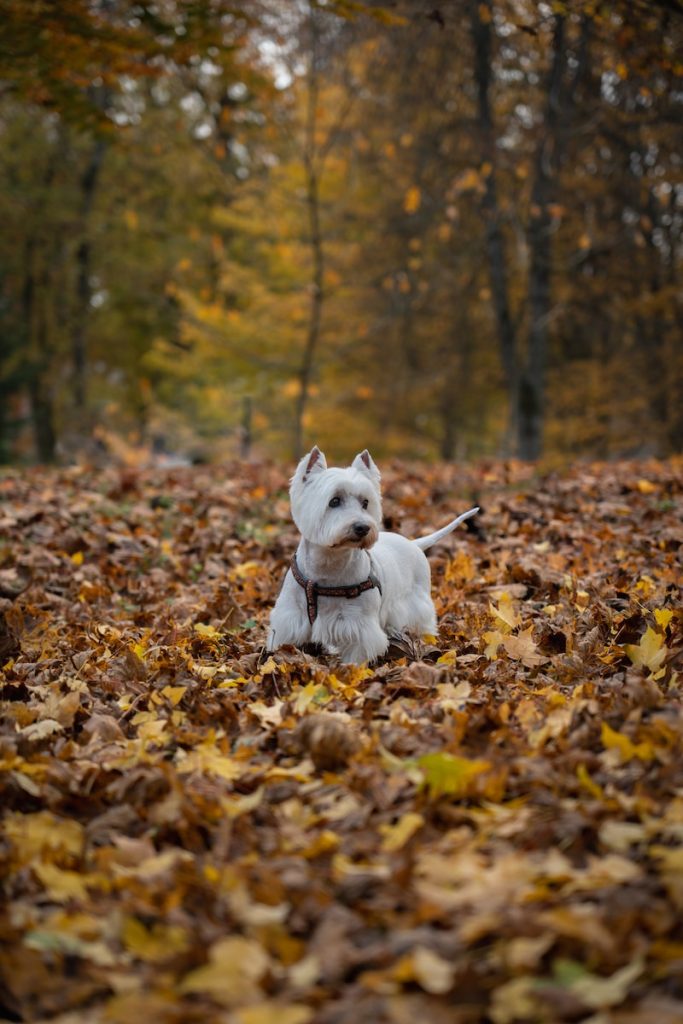This article aims to examine and provide an overview of several types of white dog breeds, including the Samoyed, Maltese, Bichon Frise, West Highland White Terrier, and Poodle. These breeds have a variety of characteristics that make them desirable companions for those looking for a loyal and loving pet.
For example, each white dog breed has its own unique personality traits and physical characteristics that set it apart from other breeds. Additionally, these breeds are typically relatively easy to care for due to their short coats and lack of shedding. As such, they can be great additions to any household regardless of size or experience level with dogs.
In summary, there is much to consider when selecting a white dog breed as a companion animal. This article will help guide readers through the process by providing an overview of the various breeds available.
Samoyed
The Samoyed, a white dog breed from the Siberian Arctic region, is known for its thick white coat and friendly demeanor. Originally bred as working dogs by the Samoyede people in Siberia to herd reindeer and pull sleds, this breed was eventually exported to Europe and America in the late 19th century.
As the Samoyed was further developed, it soon gained popularity for its beauty and intelligence. The Samoyed has a medium-sized frame with a strong build that makes them well suited for working jobs such as herding or pulling sleds. This breed is also easy to train due to its eagerness and loyalty towards its owners.
They have an unmistakable faces with almond-shaped eyes, black noses, and small ears that stick out of their white fur coat. Their double-layer coat requires regular brushing and grooming to keep it looking healthy and shiny.
This white dog breed is very sociable, making them great companions for families with children or other animals. While they enjoy being active outdoors, they are content indoors when given enough attention from their owners through daily walks or playtime activities such as fetching balls or tugging on ropes with other pets.
The Samoyed loves being around people but can be independent when required, making them great watchdogs too! These furry friends make excellent family members because of their even temperaments; however, they can become prone to separation anxiety if left alone too often or for extended periods of time without proper mental stimulation activities provided by owners. With proper training, though, these dogs will stay happy and loyal forever!
Maltese
Exhibiting a coat of luxurious fur, the Maltese is an elegant companion prized by many. This ancient dog breed’s small size and gentle temperament make it ideal for apartment living. They are intelligent and affectionate, making them easy to train with positive reinforcement techniques.
When it comes to training tips for the Maltese, consistency is key. Begin teaching basic commands such as ‘sit’ and ‘stay’ at a young age and reward each step of progress with treats or verbal praise.
This white dog breed is known to have long hair that requires regular grooming to prevent matting. Daily brushing can help keep their coats in good condition while removing loose hairs and dirt particles that can cause skin irritation if left unchecked. Bathing should be done no more than once every two weeks unless necessary due to dirt or debris in the coat; over-bathing will strip the fur of its natural oils, which protect against external irritants like dust particles. To minimize tangles, use a wide-toothed comb when brushing out any mats or knots in their fur after bathing.
It’s important to socialize your Maltese early so they become comfortable around other people and animals; this is especially important for puppies as it helps them avoid shyness and fearfulness later in life. Take them on walks regularly, allowing them time for exploration with reassuring supervision; bring treats for rewards when they interact well with other dogs or people they meet during these outings.
Maltese are known for being devoted companions who love spending time with their owners; ensuring your furry friend gets plenty of exercise, playtime, and cuddles helps keep them mentally healthy while strengthening your bond.
With proper care and commitment from you, your Maltese can live up to 15 years—a lifetime of joyous memories!
Bichon Frise
A beloved companion, the Bichon Frise is a small, fluffy breed that brings joy to many owners. The breed has a long history dating back to the 1300s in Europe and was famously seen in the paintings of Velazquez from the 1600s.
This white-coated dog is considered a hypoallergenic pet because it does not shed much hair, although regular grooming is required for their coats to stay healthy and tangle-free. Although bred as lapdogs for European aristocracy, this breed can also be quite active, with an average life expectancy of 12-15 years.
The Bichon Frise loves playing and learning new tricks; they are highly intelligent dogs who view their owners as part of the family. They make great watchdogs due to their alertness but are not naturally aggressive or territorial. Owners should socialize them early on with other pets and people so they do not become too anxious when encountering them later in life.
This white dog breed thrives on companionship and may develop separation anxiety if left alone for too long—their size makes them perfect lapdogs eager to please their families! They must have plenty of exercise each day, both mentally and physically; regular walks or playtime sessions will keep your pet happy and healthy throughout their lifetime.
Bichon Frises require minimal maintenance outside of regular brushing and occasional trimming; bathing should only be done several times a year as over-bathing can strip away natural oils from their coat which could lead to skin problems in some cases. This breed can live a long, happy life by your side with proper care, nutrition, love, attention, training, and socialization!
West Highland White Terrier
Popularly known as the ‘Westie,’ the West Highland White Terrier is a cheery canine companion distinguished by its white coat. This small and sturdy dog breed has an energetic personality, making them ideal for active families and individuals who can provide regular exercise and mental stimulation.
The Westie’s grooming requirements are relatively low maintenance; regular brushing to maintain their fur’s soft texture is all that is necessary. They require minimal exercise but appreciate daily walks or playtime in a fenced-in yard.
Aptly nicknamed “the little big dog,” the Westie loves being around people and quickly becomes a beloved part of any family. Naturally confident, they make great watchdogs without being overly aggressive – barking at unfamiliar noises but usually settling down once they realize there isn’t anything to be concerned about.
Highly intelligent and independent, this breed may need consistent guidance and training during adolescence, when they will naturally test boundaries.
The low-shedding nature of the West Highland White Terrier makes them popular among those with allergies or who are looking for less mess in their homes; however, these dogs still require weekly brushing to keep their coats free of tangles and mats. They also need routine nail trims to prevent painful splitting or cracking of nails due to overgrowth and occasional ear cleanings to prevent infections caused by bacteria buildup from wax accumulation.
Though independent-minded, providing a steady diet of positive reinforcement training methods will help ensure your Westie stays obedient throughout his life while fostering an unbreakable bond between you two! With patience and consistency – not forgetting ample amounts of love – you’ll have no trouble keeping your furry friend happy and healthy for many years!
Poodle
The Poodle is a beloved canine companion worldwide known for its intelligence, grace, and agility. It is estimated that up to 80 different breeds of dogs exist today, but the Poodle remains one of the most popular, with an estimated 26 million in existence worldwide.
This white dog breed comes in three varieties-Toy, Standard, and Miniature-and can be found in many colors such as white, black, apricot, or red. Despite their often fluffy appearance and high energy levels, Poodles are surprisingly hypoallergenic due to their low shedding rates. While no dog is completely free from shedding some hair or dander, this trait makes them ideal pets for families who have allergies.
The origins of this breed are unclear; however, it is believed they originated from Russia or Germany as water retrievers centuries ago. Their unique coats made them well-suited for hunting in cold temperatures without becoming too wet or heavy. Over time they became a favorite among European aristocrats who used them as lapdogs and show animals.
As a result of this popularity over several decades, they were bred into other shapes and sizes, making them more adaptable to life inside a home environment rather than out hunting with their owners.
Poodles require regular grooming to keep their fur and skin healthy, including regular brushing and clipping of nails when necessary. They also need daily exercise such as walks or playing fetch; however, long periods of walking should be avoided due to joint problems later in life if not carefully managed at an early age by providing appropriate rest between activities.
This breed is highly intelligent, meaning training must begin early on using positive reinforcement methods such as treats or praise to not frustrate the animal during learning new commands or tricks, which can lead to bad behavior later on if not addressed right away.
These loyal companions make excellent family members because they are affectionate towards children while also being gentle enough not to hurt them through rough play like some larger breeds inadvertently might do unintentionally due to size differences; plus, their hypoallergenic traits tend to mean fewer bouts with allergic reactions amongst family members which can create a healthier living environment overall for everyone involved.
The combination of intelligence and loyalty makes this breed an ideal pet for any household looking for a loving addition that will bring joy into their lives each day.
Frequently Asked Questions
Which white dog breed is best for apartment living?
When considering the perfect pet for an apartment, one must weigh the breed’s socializing needs and grooming requirements.
Finding a breed that is not too active or vocal and can adapt to living indoors with limited space is important.
One such dog breed is the Maltese.
This small, white-coated pup is known for its gentle nature, making it an ideal companion in tight quarters.
The Maltese requires minimal grooming and does not need much exercise or outdoor time, making it well suited for life in apartments as long as owners are willing to provide regular mental stimulation.
What is the average lifespan of a white dog breed?
The average lifespan of a dog breed depends on many factors, such as genetics, diet and exercise, and socializing habits.
Generally speaking, white dog breeds have an average lifespan of 10 to 13 years.
Factors such as size, diet prerequisites, and grooming requirements can also influence longevity in these breeds.
Smaller white dog breeds tend to live longer than larger ones due to smaller body weights.
Additionally, providing a nutritionally balanced diet with regular exercise can help prolong the life span of a white dog breed.
Socialization is also important for these breeds; early training helps reduce anxiety which can lead to improved health throughout their lives.
Are white dog breeds prone to any specific health problems?
White dog breeds are often perceived as delicate, like a flower in the wind. Regarding their health, they may be prone to some particular problems due to their coat type or socializing needs.
For instance, some white dog breeds require additional coat care because their fur is more prone to discoloration and matting than other breeds. Furthermore, they may have difficulty socializing with other dogs or people if not exposed from an early age.
It is important for owners of white dog breeds to ensure that proper medical attention and care are provided for them to live happy and healthy lives.
What is the average cost of white dog breeds?
The cost of owning a dog is important for potential pet owners to consider.
The average cost of a dog varies depending on the breed, age, and size.
White dogs may be more expensive than other breeds due to their unique coat color.
In addition to the purchase price, ongoing costs are associated with the training needs and grooming requirements of white dog breeds which should also be considered when budgeting for ownership.
Are white dog breeds good with children?
Certain dog breeds, regardless of the color of their fur, are seen as ideal family companions due to their propensity for being loving and affectionate.
White dogs may be particularly well-suited for households with children, given their exercising needs, grooming requirements, and general temperament.
White dogs often make excellent playmates for young kids like a ray of sunshine makes a house brighter – they bring joy and vitality to any home.
For those who have young children at home or plan on having them in the future, investing in a white dog breed may be an excellent choice as they can provide companionship, loyalty, and protection, all while being low-maintenance caretakers.
Conclusion
White dog breeds offer many options for potential pet owners. There is something for everyone, from the fluffy Samoyed to the elegant Maltese.
The Bichon Frise and West Highland White Terrier are popular due to their friendly dispositions and hypoallergenic coats. The Poodle also stands out with its intelligence and versatility.
Each breed has something unique to offer its owners, which makes them great companions.
These white dogs bring joy and happiness into homes worldwide like a ray of sunshine on a cloudy day. They provide unconditional love and loyalty that can help people get through tough times and make everyday life more bearable.
With so many excellent attributes, it’s no wonder these white breeds have become so beloved by families everywhere—they are man’s best friend!
Discover a world of possibilities for pet owners with Bone Voyage Dog Rescue! We aim to find forever homes for these strays and unwanted dogs in Mexico.
Experience the joy and happiness these white dogs bring into homes like a ray of sunshine on a cloudy day. They offer unwavering love and loyalty, providing solace during tough times and making everyday life more bearable.
Contact us at +52 3329718011 or [email protected] to help these dogs find their forever homes today! Join the countless families who have embraced these beloved white breeds as man’s best friend.



